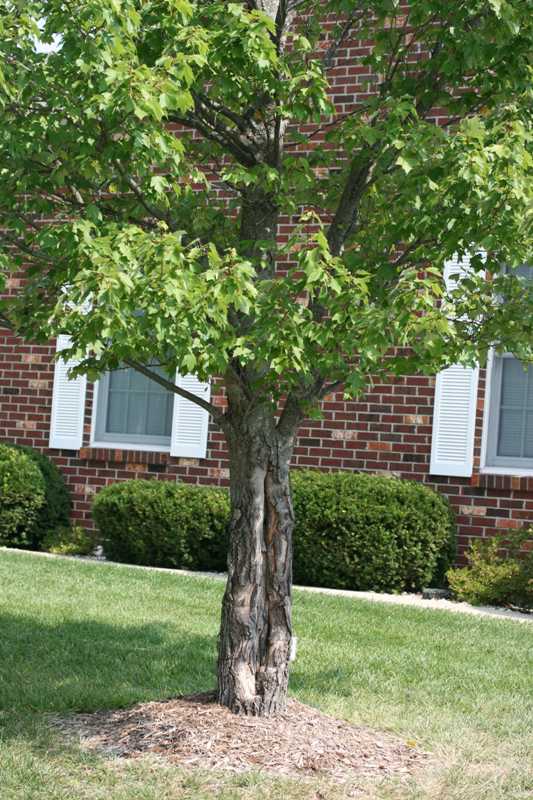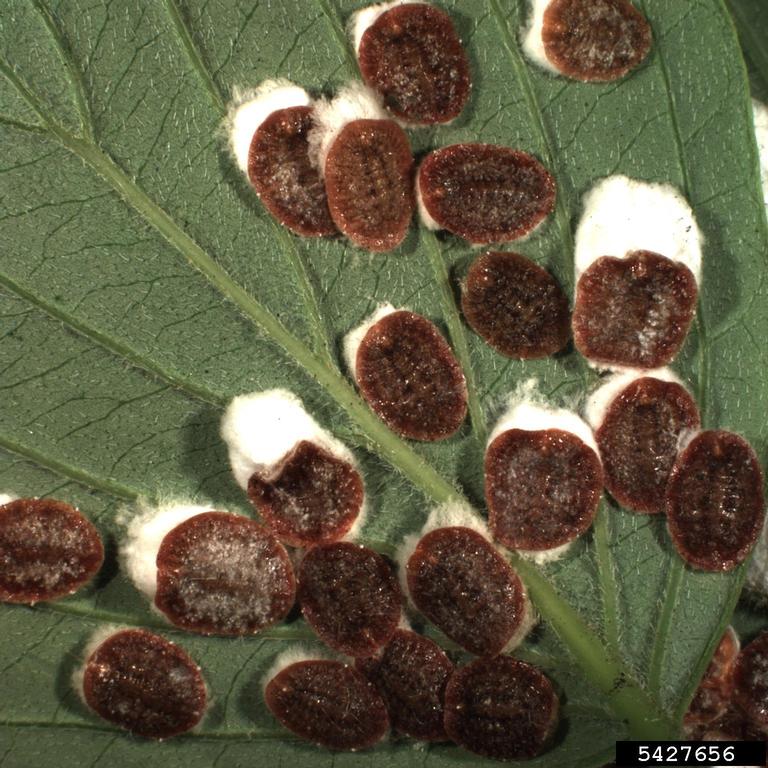 |
Failure to flower
Seed grown dogwoods may take from seven to 10 years before they flower although some may flower at a much younger age. Since precocious flowering is often the basis for selecting dogwood cultivars, a grafted cultivar may be a better purchase if early flowering is a concern. However, balled and burlapped cultivars may bloom the first year but not rebloom until their root systems are reestablished, which can take up to four years. |
 |
Leaf scorch
Flowering dogwoods are understory trees that do not tolerate long periods of full sun. In the heat of summer and/or during periods of drought the edges of leaves may turn brown. Provide additional moisture if required or afternoon shade--noon to 5 p.m. |
 |
Drought and water stress
Drought and water stress can cause leaf scorch, as discussed above, or it can lead to wilting, especially in recently transplanted specimens located in full sun, in specimens located in a wet area, or in specimens with a damaged vascular system. Even when the soil is moist, a plant with a damaged or reduced root system may not be able to move water to the leaves fast enough to keep up with water loss in the leaves. The result is wilted leaves.
Lookalikes: all root rots, borers, crown canker |
 |
Sunscald
Sunscald is caused by exposure of the bark to the winter sun. This usually occurs on the southwest side of the tree, thus sunscald is often called southwest injury. The tissue beneath the bark breaks dormancy during the day, then freezes during the night, resulting in an elongated wound that appears discolored and sunken. Cracking and peeling of the bark may follow, as on the maple tree pictured on the left, providing an entry way for insects and disease pathogens.
Lookalikes: Dogwood borer |
|

M.A. Hansen, VPISU, Bugwood.org
|
Spot anthracnose and other leaf spots
Leaf spots on flowering dogwoods are common and are usually only cosmetic. A common leaf spot is spot anthracnose with small reddish-purple spots along leaf veins and/or on flower petals (bracts), pictured on the left. It is more prevalent in wet weather and usually only causes cosmetic damage.
Lookalikes: Do not confuse with dogwood anthracnose canker, which is deadly to the tree. |
|


R. L. Anderson, USFS, Bugwood.org
|
Dogwood anthracnose canker
This is a serious fungal disease of dogwoods that is prevalent in states east of Missouri. The disease, Discula destructiva, causes leaf, twig and branch dieback beginning in the lower part of the tree. Numerous small shoots may grow from the trunk. The tree usually dies in three to five years.
Lookalikes: Root rots, borers, crown canker |
|

J. Hartman, UKY, Bugwood.org
|
Powdery mildew
This white, powdery growth is common on dogwood leaves and twig tips. It is usually only cosmetic. |
 |
Botrytis blight or gray mold
Gray mold is a common fungal disease on fading flowers. During wet spring weather, falling dogwood petals (bracts) develop mold, as in the tan spots with pink haloes pictured on the left. Infected petals can then infect the leaves they rest upon spreading the disease. It is usually only cosmetic. |
|

Oregon State University
|
Crown canker
Crown canker, Phytophthora cactorum, is the most serious disease of flowering dogwoods in the Eastern United States. Leaves are small or undersized and of a lighter green color and may curl. The plant appears stressed especially during dry periods. Later twigs and branches may die, usually on one side of the tree but the disease spreads over time. Though not always noticed, the cause of the problem is a canker (dead area on the lower trunk or branches) that is slowly girdling the trunk and killing the
cambium. When the girdling is complete the tree will die. The disease is serious and results in tree death. Initial infection could have entered through transplanting wounds or through wounds caused by insects, animals, sunscald, lawn mowers or weed whips. Do not replant a dogwood in the same area and always protect the base of trees from damage.
Lookalikes: Armillaria root rot, sunscald |
|

FDACS-DPI Archive, FDACS, Bugwood.org

|
Armillaria root rot
Armillaria is an aggressive root rot that can attack stressed or otherwise healthy plants. The fungus girdles the base of the tree killing the cambium (top image). Honey mushrooms at the base of a plant (bottom image) are the fruiting bodies of the fungus and are a sure sign of the disease. Plant death is quick. Do not replace with a plant susceptible to armillaria in the same location.
Lookalikes: Any root or stem problem may cause a dogwood to decline and die, but the honey mushrooms (bottom image) are distinctive to armillaria root rot. |
|

J.A. Weidhass, VPISU, Bugwood.org

J. Solomon, USFS, Bugwood.org
|
Dogwood borer
The most devastating borer of dogwoods is the dogwood borer, Synanthedon scitula. The larvae of a clear-wing moth, this caterpillar tunnels into the trunk of the tree and eventually girdles the tree. Weakened trees are more susceptible. An early symptom may be the sloughing of loose bark. Crown dieback and the development of adventitious growth follows. Small wet areas on the bark in early summer may indicate young borer activity. Once
inside the trunk, control is difficult and trees usually die within a year or so.
Lookalikes: Other borers, sunscald, weed whip damage, dogwood anthracnose canker, root rots, crown canker |
 |
 |
|
N. Wright, FDACS-
DPI, Bugwood.org
|
J. Solomon, USFS,
Bugwood.org
|
|
Flat-headed appletree borer
Adult beetles of the flat-headed appletree borer (Chrysobathris fomorata) lay eggs on the bark of stressed trees. The young larvae hatch and tunnel into the stems and trunks, which results in branch dieback or even death of the tree from the feeding. The first sign of a borer infestation may be white, frothy ooze coming from cracks and crevices in the trunk or branches. Flat areas develop where feeding is occurring and the bark may split in these
areas. Once borers are in the trunk of the tree pesticides are usually ineffective and tree demise is inevitable.
.
Lookalikes: Other borers, sunscald, weed whip damage, dogwood anthracnose canker, root rots, crown canker |
 |
Scale insects
Several scale insects may be found feeding on flowering dogwoods. Cottony maple scale is common. Look for colored bumps on a leaf or stem that can be flicked off with the point of a knife or a fingernail. Objects beneath where the scale insects are feeding may be shiny and sticky, or blackened and sticky. |
| |
Last updated: 2/2012 View a pdf of this guide |